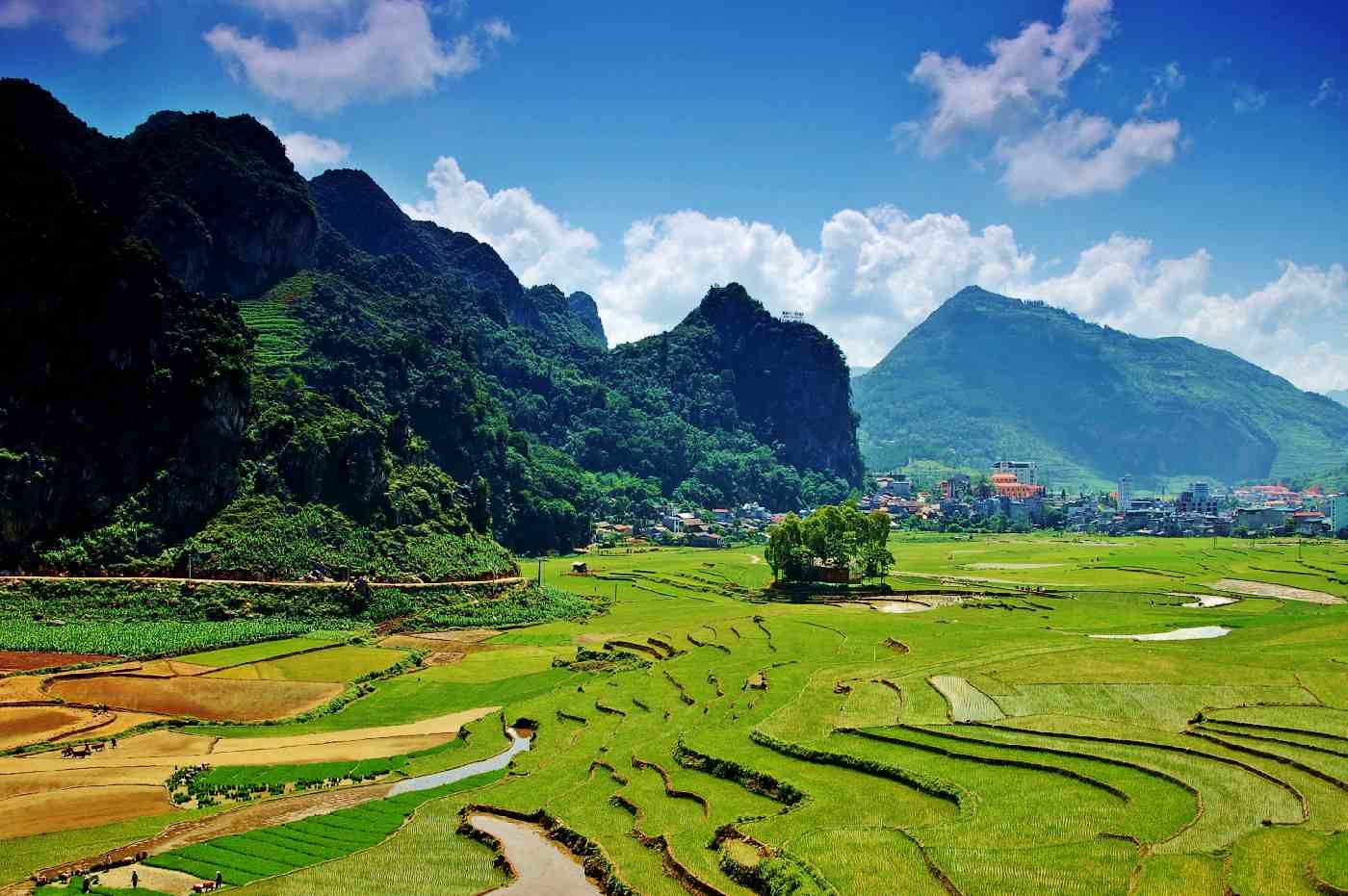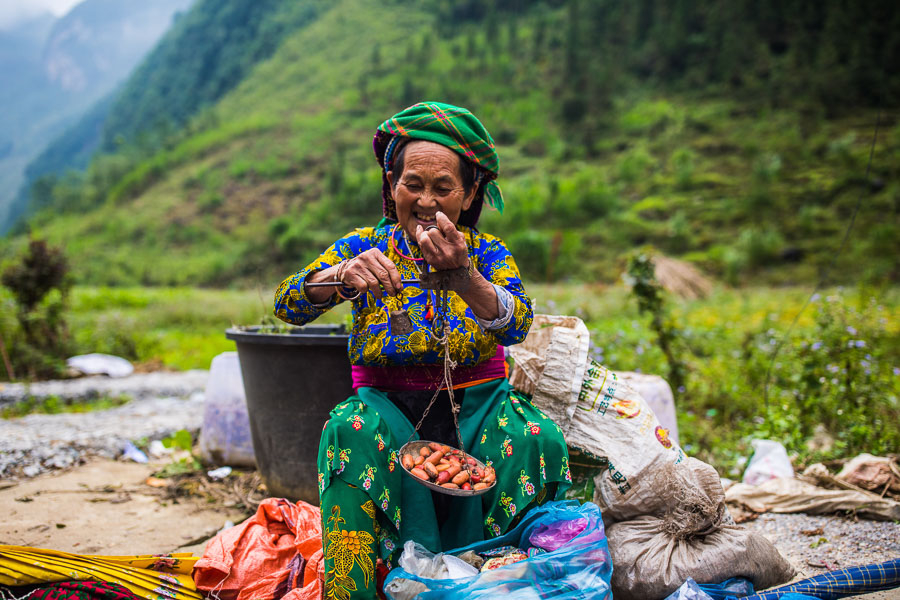Ha Giang – Vietnam’s Northern Frontier of Untamed Beauty
Nestled in the far north of Vietnam, Ha Giang captivates travelers with its breathtaking landscapes, towering limestone mountains, and winding passes carved into the cliffs. But beyond the dramatic scenery, what truly defines Ha Giang is the authentic warmth and resilience of its people.
This frontier province offers more than just majestic views—it invites you to immerse yourself in the rich cultures of ethnic minorities, discover untouched villages, and taste flavors unique to the northeastern highlands. From vibrant local markets to mist-covered valleys, every moment in Ha Giang is a journey into something real, raw, and unforgettable.
Top Natural and Cultural Attractions in Ha Giang
Dong Van Karst Plateau Geopark
Stretching across the districts of Quan Ba, Yen Minh, Dong Van, and Meo Vac, the Dong Van Karst Plateau is a geological wonder and a UNESCO Global Geopark since 2010. With its striking limestone formations, deep canyons, and vibrant ethnic culture, the plateau offers a rare look into both the Earth’s history and human resilience.

Lung Cu Flagpole – The Northernmost Point of Vietnam
Standing tall at 1,700 meters above sea level, the Lung Cu Flagpole in Dong Van District is a national symbol marking Vietnam’s northernmost frontier. Visitors climb 140 spiral steps to reach the 33.15-meter-high monument, whose octagonal base and bronze drum carvings reflect traditional Vietnamese culture. From the top, panoramic views stretch far across the borderlands.

Quan Ba Heaven’s Gate & Twin Mountains (Fairy Bosom)
Located at 1,500 meters above sea level, Heaven’s Gate in Quan Ba is the gateway to the Dong Van Plateau. It was once the entrance to a historical autonomous region. Nearby, the Twin Mountains of Quan Ba, often called the “Fairy Bosom,” rise strikingly from the rice terraces and limestone landscape. Their natural symmetry and accompanying legend make them an iconic stop.

Ma Pi Leng Pass – The King of Vietnam’s Mountain Roads
Regarded as one of the most dangerous and spectacular mountain passes in Vietnam, Ma Pi Leng Pass winds through the highlands at around 2,000 meters above sea level, connecting Dong Van and Meo Vac. The pass features dramatic cliffs, deep valleys, and sedimentary rock formations over 400 million years old. Whether on two wheels or four, the journey across Ma Pi Leng is unforgettable.

Nine Bends Pass (Bac Sum Slope)
This famously winding road, also known as the Nine Bends Pass, connects Pho Cao to Sung La. The pass challenges travelers with its sharp curves, steep ascents, and sheer drops, but rewards them with panoramic views of the highland scenery. It’s a must-see for photography lovers and thrill-seekers alike.
Cuisine in Ha Giang: A Taste of the Highlands
Ha Giang’s cuisine is as bold and authentic as its rugged landscapes, shaped by the lives and traditions of its many ethnic communities. From hearty mountain stews to colorful sticky rice, every dish tells a story of culture, climate, and creativity. Here are some must-try local specialties:
Thắng Cố
A signature dish of the H’Mong people, Thắng Cố is a rich stew made from horse meat, innards, and a blend of mountain herbs and spices. Traditionally cooked in large pots during festivals or market days, it offers an earthy, warming flavor unlike anything else.

Xôi Ngũ Sắc (Five-Colored Sticky Rice)
This festive dish is made with glutinous rice dyed naturally using plants like turmeric, pandan leaves, and magenta flowers. Xôi Ngũ Sắc is not only visually stunning but also carries deep symbolic meaning for ethnic minorities, especially during traditional celebrations.

Bánh Cuốn (Steamed Rice Rolls)
Unlike the Hanoi version served with grilled pork, Ha Giang’s bánh cuốn is often served with a hearty pork bone broth, offering a warm and savory twist. Filled with minced pork and wood ear mushrooms, it’s a favorite breakfast dish among locals.
Lợn Cắp Nách (Free-Range Mountain Pork)
Literally meaning “pig carried under the arm,” this dish features small, free-roaming pigs raised by ethnic minorities. The pork is marinated with local herbs and spices, then grilled or roasted to achieve its juicy, flavorful profile.

Thịt Trâu Gác Bếp (Smoked Buffalo Meat)
Prepared by ethnic minority groups, smoked buffalo meat is hung above the kitchen fire to dry naturally over time. The result is a chewy, smoky delicacy full of flavor—often enjoyed with rice wine and served during special occasions.

When is the Best Time to Visit Ha Giang?
Ha Giang offers distinct experiences across all four seasons, but some periods stand out as particularly ideal for travel:
September to November
- Widely regarded as the best time to visit, this period features cool, dry weather and the iconic golden terraced rice fields during the harvest season. It’s also festival season in many ethnic villages, making it a perfect time for cultural immersion and photography.
March to April
- Spring in Ha Giang is vibrant with blooming white plum blossoms and yellow mustard flowers, creating a romantic, colorful landscape. The weather is mild and ideal for trekking and outdoor exploration.
December to February
- Winter brings chilly temperatures and crisp mountain air, especially at higher elevations. Though less crowded, this season offers clear skies, quiet trails, and a glimpse into local life during the colder months.
May to August
- This is Ha Giang’s rainy season, when the region turns lush and green. While landslides and road conditions can be a challenge, the scenery is at its most vivid. Adventurous travelers will enjoy the refreshing atmosphere and fewer tourists.
How to Get to Ha Giang
Ha Giang does not yet have an airport or railway station, but it is still easily accessible by road from various parts of northern Vietnam.
By Bus
-
From Hanoi: Several companies operate daily buses between Hanoi and Ha Giang, including sleeper buses for overnight travel. The journey takes about 6–8 hours depending on traffic.
-
From Other Cities: There are also direct buses from Ha Long, Sapa, Cao Bang, and other northern destinations. Booking in advance is recommended, especially during weekends or festivals.
By Car
-
Self-Drive: You can rent a car or motorbike in Hanoi and drive to Ha Giang in 6–8 hours. The route is scenic but requires caution due to winding mountain roads.
-
Private Car with Driver: A more comfortable and flexible option, ideal for families or groups who prefer a guided experience.
By Train
- Ha Giang does not have a railway station. If you’re coming from Lao Cai or Sapa, take a train to Hanoi, then continue by road to Ha Giang.
By Motorbike
- Many travelers choose to ride motorbikes from Hanoi to Ha Giang and continue exploring via the famous Ha Giang Loop. This is one of Vietnam’s most scenic road trips, but it’s best suited for experienced riders due to the challenging terrain.
Conclusion
Ha Giang is more than just a destination—it’s a journey into Vietnam’s raw beauty, rich culture, and untamed highlands. Whether you’re drawn by golden rice terraces, limestone peaks, winding mountain roads, or the warmth of its ethnic communities, Ha Giang promises an experience that’s both unforgettable and deeply authentic. Let PHM Travel guide you through every bend and pass on this incredible frontier adventure.


 Tiếng Việt
Tiếng Việt